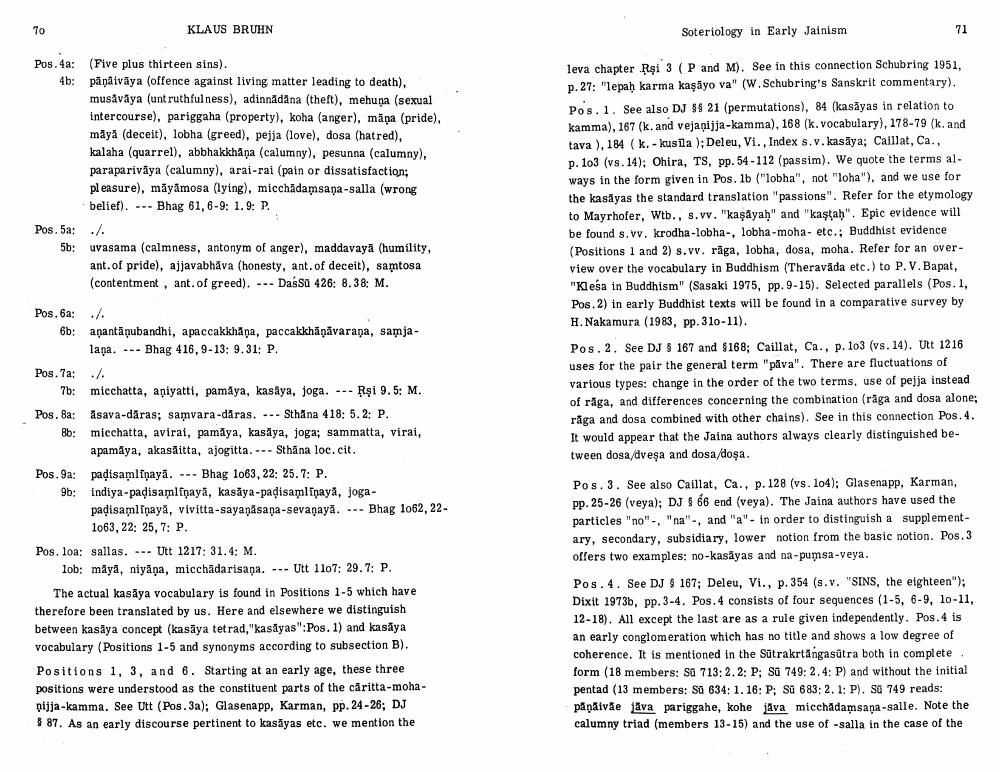________________
KLAUS BRUHN
Soteriology in Early Jainism
Pos. 4a: (Five plus thirteen sins). 4b: panaivāya (offence against living matter leading to death),
musavaya (untruthfulness), adinnadana (theft), mehuņa (sexual intercourse), pariggaha (property), koha (anger), māņa (pride), maya (deceit), lobha (greed), pejja (love), dosa (hatred), kalaha (quarrel), abbhakkhāņa (calumny), pesunna (calumny), paraparivāya (calumny), arai-rai (pain or dissatisfaction; pleasure), māyāmosa (lying), micchadamsana-salla (wrong
belief). --- Bhag 61, 6-9: 1.9: P. Pos. 5a: A 5b: uvasama (calmness, antonym of anger), maddavayā (humility,
ant. of pride), ajjavabhäva (honesty, ant.of deceit), samtosa (contentment, ant. of greed). --- Dassa 426: 8.38: M.
leva chapter Rşi 3 (P and M). See in this connection Schubring 1951, p. 27: "lepaḥ karma kaşāyo va" (W. Schubring's Sanskrit commentary). Pos. 1. See also DJ $ 21 (permutations), 84 (kasayas in relation to kamma), 167 (k. and vejanijja-kamma), 168 (k.vocabulary), 178-79 k. and tava ), 184 (k. - kusila ); Deleu, Vi., Index s.v.kasaya; Caillat, Ca.. p. 103 (vs. 14); Ohira, TS, pp. 54 - 112 (passim). We quote the terms always in the form given in Pos. 1b ("lobha", not "loha"), and we use for the kasayas the standard translation "passions". Refer for the etymology to Mayrhofer, Wtb., s.v. "kaşāyaḥ" and "kaştah". Epic evidence will be found s.v. krodha-lobha-, lobha-moha- etc.; Buddhist evidence (Positions 1 and 2) s.vv. räga, lobha, dosa, moha. Refer for an overview over the vocabulary in Buddhism (Theravada etc.) to P. V. Bapat, "Klesa in Buddhism" (Sasaki 1975, pp. 9-15). Selected parallels (Pos. 1, Pos. 2) in early Buddhist texts will be found in a comparative survey by H. Nakamura (1983, pp. 310-11). Pos. 2. See DJ S 167 and $168; Caillat, Ca., p. 103 (vs. 14). Utt 1216 uses for the pair the general term "pava". There are fluctuations of various types: change in the order of the two terms, use of pejja instead of rāga, and differences concerning the combination (raga and dosa alone; råga and dosa combined with other chains). See in this connection Pos. 4. It would appear that the Jaina authors always clearly distinguished between dosa/dvesa and dosa/dosa.
Pos. 6a: 6b: anantā mubandhi, apaccakkhāņa, paccakkha avarana, samja
lana. --- Bhag 416, 9-13: 9.31: P. Pos. 7a: 4
7b: micchatta, aniyatti, pamaya, kasaya, joga. - Rşi 9.5: M. Pos. 8a: Asava-daras; samvara-daras. --Sthana 418: 5.2: P. 8b: miechatta, avirai, pamaya, kasaya, joga; sammatta, viral,
apamaya, akasitta, ajogitta... Sthana loc. cit. Pos. 9a: padisamliņayā. --- Bhag 1063, 22: 25.7: P. 9b: Indiya-padisamliņayā, kasāya-padisamliņaya, Joga -
padisamlipaya, vivitta-sayaņāsapa-sevanaya. --- Bhag 1062, 22
1063, 22: 25,7: P. Pos. loa: sallas. --- Utt 1217: 31.4: M.
lob: maya, niyapa, micchädarisaņa... Utt 1107: 29.7: P.
The actual kasaya vocabulary is found in Positions 1-5 which have therefore been translated by us. Here and elsewhere we distinguish between kasaya concept (kasāya tetrad,"kasayas":Pos. 1) and kasaya vocabulary (Positions 1-5 and synonyms according to subsection B). Positions 1, 3, and 6. Starting at an early age, these three positions were understood as the constituent parts of the caritta-mohapijja-kamma. See Utt (Pos. 3a); Glasenapp. Karman, pp. 24-26; DJ 8 87. As an early discourse pertinent to kasayas etc. we mention the
Pos. 3. See also Caillat, Ca., p. 128 (vs. 104); Glasenapp, Karman, pp. 25-26 (veya); DJ $ 66 end (veya). The Jaina authors have used the particles "no", "na", and "a"- in order to distinguish a supplementary, secondary, subsidiary, lower notion from the basic notion. Pos. 3 offers two examples: no-kasayas and na-pumsa-veya.
Pos. 4. See DJ & 167; Deleu, Vi., p. 354 (s.v. "SINS, the eighteen"); Dixit 1973b, pp. 3-4. Pos. 4 consists of four sequences (1-5, 6-9, 10-11, 12-18). All except the last are as a rule given independently. Pos. 4 is an early conglomeration which has no title and shows a low degree of coherence. It is mentioned in the Sūtrakrtangasútra both in complete form (18 members: Su 713: 2.2: P: Su 749: 2.4: P) and without the initial pentad (13 members: Su 634: 1. 16: P; SG 683: 2.1: P). SQ 749 reads: papaivae java pariggahe, kohe java miechadamsaņa-salle. Note the calumny triad (members 13-15) and the use of -salla in the case of the




